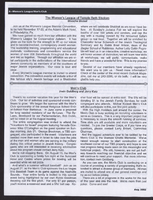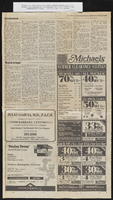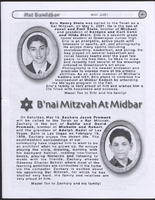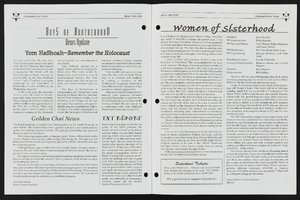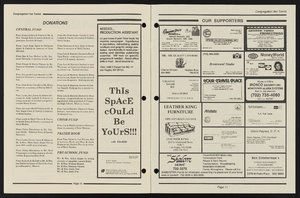Search the Special Collections and Archives Portal
Search Results

Interview with Stuart C. Black, February 21, 2006
Date
2006-02-21
Archival Collection
Description
Narrator affiliation: Scientist, U.S. Public Health Service; U.S. Environental Protection Agency REECo/Bechtel
Text
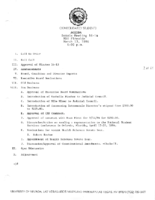
Meeting minutes for Consolidated Student Senate University of Nevada, Las Vegas, March 13, 1986
Date
1986-03-13
Archival Collection
Description
Includes meeting agenda and minutes along with additional information about amendments to the senate bylaws. CSUN Session 16 (Part 1) Meeting Minutes and Agendas.
Text
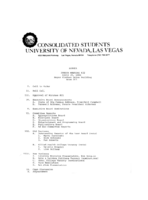
Meeting minutes for Consolidated Student Senate, University of Nevada, Las Vegas, April 29, 1980
Date
1980-04-29
Archival Collection
Description
Includes meeting agenda and minutes along with a letter. CSUN Session 9 Meeting Minutes and Agendas.
Text
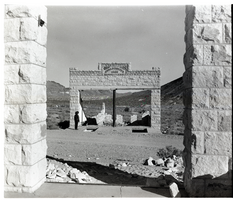
Film transparency of the ruins of the H. D. and L. D. Porter Brothers Store, Rhyolite, Nevada, November 25, 1948
Date
1948-11-25
Archival Collection
Description
An unidentified person looks at the ruins of the H. D. and L. D. Porter Brothers Store in Rhyolite, Nevada. The remains of two wooden buildings and several mining tailing piles are visible in the background. Originally from Illinois, the brothers opened their first store in Johannesburg, Ca. in 1902. Moving with the mining booms, they opened stores in Ballarat, Beatty, Pioneer and Rhyolite. From the Ballarat store, H. D. Porter loaded thirty tons of merchandise onto an 18-mule team freight wagon and came east across Death Valley to the Bullfrog District. The original store was built on Main St. After the move to Golden St., the wooden building was used as a furniture store for the Porter Brothers. With the purchase of a lot on Golden Ave. the construction of a new stone building began in July 1906 and was finished four months later. According to the Rhyolite Herald, November 1906 "This is a large substantial structure, practically fireproof, and occupies a prominent site on Golden Street. The main floor is 30 x 80 feet, with a basement and gallery." Nels Linn was the contractor who did the stonework. The estimated cost was $10,000 for the complete construction of the building. One of the signs that hung from the Porter Brothers Store was "All Things Good But Whiskey". With all the saloons already established in Rhyolite, the Porter Brothers maintained a reputation of never selling liquor. Rhyolite is a ghost town in Nye County, Nevada. It is in the Bullfrog Hills, about 120 miles (190 km) northwest of Las Vegas, near the eastern edge of Death Valley. The town began in early 1905 as one of several mining camps that sprang up after a prospecting discovery in the surrounding hills. During an ensuing gold rush, thousands of gold-seekers, developers, miners and service providers flocked to the Bullfrog Mining District. Many settled in Rhyolite, which lay in a sheltered desert basin near the region's biggest producer, the Montgomery Shoshone Mine. Rhyolite declined almost as rapidly as it rose. After the richest ore was exhausted, production fell. The 1906 San Francisco earthquake and the financial panic of 1907 made it more difficult to raise development capital. In 1908, investors in the Montgomery Shoshone Mine, concerned that it was overvalued, ordered an independent study. When the study's findings proved unfavorable, the company's stock value crashed, further restricting funding. By the end of 1910, the mine was operating at a loss, and it closed in 1911. By this time, many out-of-work miners had moved elsewhere, and Rhyolite's population dropped well below 1,000. By 1920, it was close to zero. After 1920, Rhyolite and its ruins became a tourist attraction and a setting for motion pictures. Most of its buildings crumbled, were salvaged for building materials, or were moved to nearby Beatty or other towns, although the railway depot and a house made chiefly of empty bottles were repaired and preserved. The town is named for rhyolite, an igneous rock composed of light-colored silicates, usually buff to pink and occasionally light gray. It belongs to the same rock class, felsic, as granite but is much less common.
Image
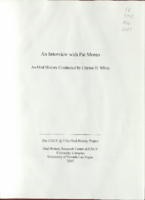
Transcript of interview with Pat Moreo by Claytee D. White, September 13, 2007
Date
2007-09-13
Archival Collection
Description
Pat Moreo was born in the borough of Queens in New York City. His family moved to the Finger Lakes region when he was ten and he finished grade school and high school in Horseheads. He grew up in a close Italian family watching his mother and his grandparents cook both southern and northern Italian dishes. Pat shares his family history, explaining how his maternal grandfather was originally a tunnel builder but quit that trade to open a luncheonette in New York, own and run apartment buildings, and become the first Pepsi Cola distributor in Queens Other family members ran the Pepsi franchise after his grandfather died. Mr. Moreo graduated from New York City Tech in 1967. He worked that summer at various hotels and restaurants and then decided to get his bachelor's degree in hotel and culinary work. He and several friends applied to Oklahoma State and were accepted, but were convinced at the last moment to apply at UNLV. They were accepted as students by Jerry Vallen, the new chair, and arrived in Las Vegas on Labor Day weekend. Coming from New York to Las Vegas in September of 1967 was like landing on Mars Pat describes in detail the heat, the small campus, and the supportive staff at UNLV. People like Jerry Vallen, Boyce Phillips, George Bussel, and Bruce Balton made the newcomers feel welcome, inviting them into their homes and making sure they were comfortable. Pat lived in Tonopah Hall and found work in the student union while working on his degree. After graduation in 1969, Pat went on to work for Harris Kerr Forster and Company (now PKF Consulting) and traveled for them all around California. After a stint in the Naval Reserves, he worked for Howard Johnson Company in NYC, and at the same time completed his master's degree at Cornell University. In 1975 he returned to UNLV as an instructor, earned a PhD in Ed Administration under George Kavina and went on to work at Penn State and New Mexico State. Pat returned to UNLV in 2006 to head the hotel/culinary department and is working with faculty and staff to make revitalizing changes. He expresses his opinions about the importance of food in every culture, explains his position on making people feel welcome, and shares his thoughts on what the future holds for Harrah's College of Hotel Administration.
Text
Pagination
Refine my results
Content Type
Creator or Contributor
Subject
Archival Collection
Digital Project
Resource Type
Year
Material Type
Place
Language
Records Classification

